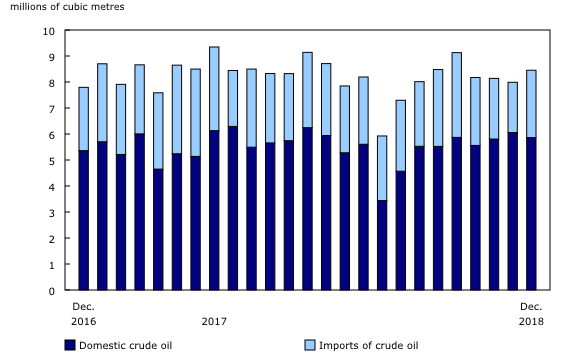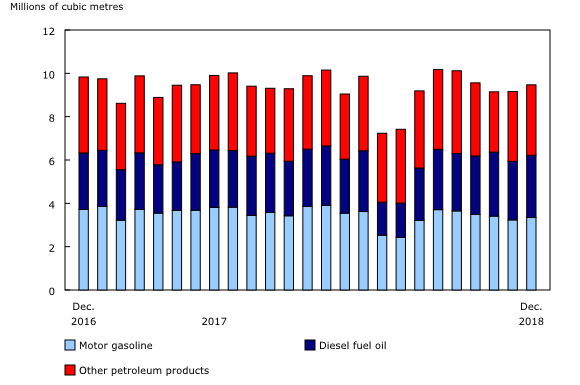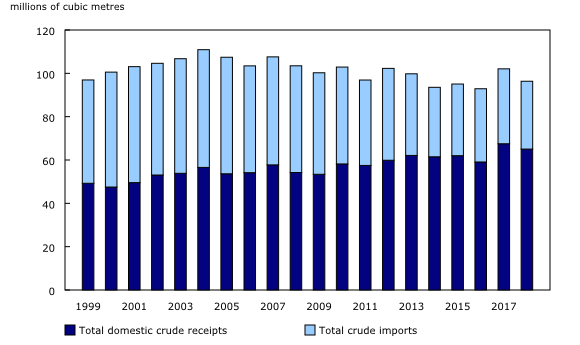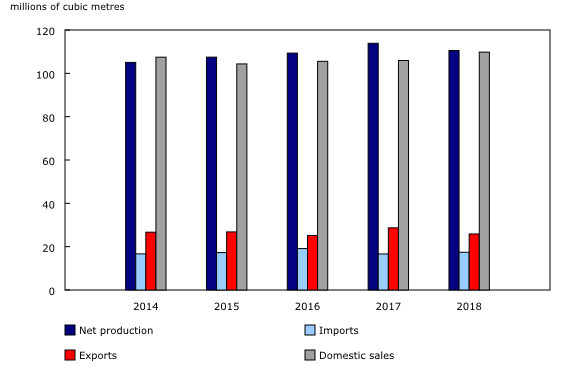Supply and disposition of refined petroleum products, December 2018
Archived Content
Information identified as archived is provided for reference, research or recordkeeping purposes. It is not subject to the Government of Canada Web Standards and has not been altered or updated since it was archived. Please "contact us" to request a format other than those available.
Released: 2019-03-15
Refinery receipts of crude oil and refinery production decreased in December, while domestic sales of refined petroleum products increased compared with the same month in 2017.
Refinery receipts down
Canadian refineries received 8.5 million cubic metres of crude oil in December, down 7.5% from the same month a year earlier.
Over the same period, domestic crude oil received by refineries was down 6.1% to 5.9 million cubic metres.
Imports of crude oil to refineries decreased 10.6% to 2.6 million cubic metres.
Crude oil inventories held at refineries totalled 3.4 million cubic metres in December, up 8.4% from the same month in 2017.
Crude oil used in refinery production declines
Total crude oil and equivalent products used in refinery production decreased 5.7% year over year to 8.4 million cubic metres in December.
Refinery production down and sales up
Production of refined petroleum products was down 4.3% year over year to 9.5 million cubic metres in December. The main contributor to the decrease was motor gasoline (-13.2%).
Domestic sales increased 3.2% to 9.0 million cubic metres.
Imports and exports decline
In December, Canadian imports of refined petroleum products totalled 1.4 million cubic metres, down 0.8% from the same month a year earlier.
Meanwhile, exports of refined petroleum products declined 14.8% to 2.0 million cubic metres.
Inventories up
Closing inventories of refined petroleum products held by refineries increased 4.2% year over year to 8.1 million cubic metres in December.
2018 annual review
Crude oil receipts down
Canadian refineries received 96.3 million cubic metres of crude oil in 2018, down 5.6% from a year earlier. Decreases were seen in both crude imports (-9.4%) and domestic crude (-3.7%). Imports accounted for 32.5% of crude oil receipts in 2018, their lowest share since 1989.
Refinery production down and sales up
In 2018, refinery production totalled 110.5 million cubic metres, down 2.9% from 2017 when production reached a seven-year high at 113.9 million cubic metres. Widespread refinery shutdowns during the second quarter contributed to the overall decrease in refinery production in 2018.
Domestic sales of refined petroleum products increased 3.7% to 109.8 million cubic metres in 2018. Sales of diesel (+6.1%), aviation turbo fuel (+11.4%), heavy fuel oil (+26.6%) and petrochemical feedstocks (+7.6%) were all up compared with 2017.
Imports up and exports down
Canada imported 17.4 million cubic metres of refined petroleum products in 2018, up 4.7% from 2017. Meanwhile, Canadian exports of refined petroleum products fell 9.9% to 25.9 million cubic metres.
Note to readers
The Monthly Refined Petroleum Products survey collects data on the activities of every Canadian refinery involved in the production of refined petroleum products (North American Industry Classification System [NAICS] 324000) and of selected major distributors of these products (NAICS 412000).
In early 2019, this Daily article will be part of a new consolidated monthly energy release where data from multiple monthly energy surveys will be released on the same day.
Additionally, the monthly refined petroleum products program will be updated starting with the January 2019 reference month.
Crude oil and equivalent charged are combined with other materials charged as feedstocks to calculate total refinery production in order to obtain total refined petroleum products plus refinery losses.
Total other materials charged as feedstocks are materials from petroleum or other sources which are external to the refinery and which are charged to the refinery as inputs.
Refinery losses are the volume difference between production of refined petroleum products and crude oil and other materials charged. Most products produced by modern refineries have a specific gravity (density) that is lighter than crude oil. The resulting volumetric gain is shown as deduction from refinery production to ensure balancing of outputs and inputs.
Domestic sales include all sales by reporting companies, excluding exports and sales to other reporting companies.
Refinery receipts of crude oil and equivalent hydrocarbons (condensates and pentanes plus) from domestic and foreign sources are for refinery consumption or storage.
Data are subject to revisions.
Contact information
For more information, or to enquire about the concepts, methods or data quality of this release, contact us (toll-free 1-800-263-1136; 514-283-8300; STATCAN.infostats-infostats.STATCAN@canada.ca) or Media Relations (613-951-4636; STATCAN.mediahotline-ligneinfomedias.STATCAN@canada.ca).
- Date modified:







